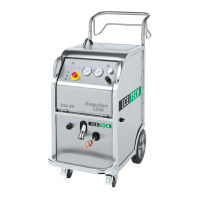6
GENERAL INFORMATION
The Evolution Line manual is for the Elite 20 and the Xtreme 40 dry ice blasting
machines produced by IceTech. IceTech machines and accessories have been
developed to supply cleaning equipment which minimizes consequential cleaning
costs and combines the best characteristics of sand blasting and steam cleaning.
DRY AND THERMAL CLEANING PROCESS
Dry ice blasting provides a dry cleaning process (similar to sand blasting), AND a
thermal cleaning process (familiar in steam cleaning). The blasting media itself (dry
ice pellets) sublimates; this means that in most cases the process can be used for
cleaning components, machinery and plant equipment without dismantling and
often without having to cover adjacent plant equipment.
NO RESIDUAL BLASTING MEDIA
Dry ice blasting provides a dry and gentle, but extremely efcient, cleaning
process that leaves no residual blasting media to be disposed of, and no undesired
substances that might penetrate into or be deposited on machines and plant
components. This means that cleaning by dry ice blasting becomes an excellent
alternative to cleaning with traditional methods.
DRY ICE BLASTING: HOW IT OPERATES
DRY ICE PELLETS
The dry ice blasting machine uses small CO
2
”particles” as the blasting medium,
called dry ice pellets (CO
2
– the chemical symbol for carbon dioxide). In a
machine commonly known as a pelletizer, liquid CO
2
is used to produce hard
and uniform dry ice pellets. The pellets are approx. 3 mm (0.1 inch) in diameter
and approx. 10 mm (0.4 inch) in length – or rice-sized. These dry ice pellets have
a temperature of -79°C/-110°F. When used for dry ice blasting, the pellets are
blasted onto the object to be cleaned at a very high velocity. On contact with
the surface of the object, they immediately change from a solid to a gaseous
form as they heat up on impact. This change from a solid to a gaseous form, the
accompanying tremendous expansion in volume, the high kinetic energy and the
low temperatures are the most important factors which result in the loosening of
impurities.
METHOD
The dry ice blasting machine contains a dry ice pellet tank and a dosing unit,
which doses the dry ice pellets into the jet of compressed air. By means of the
compressed air, the dry ice is transported through a special blasting hose to the
blasting gun and nozzle. In the blasting gun, the air stream is accelerated, and the
dry ice pellets leave the nozzle of the blasting gun at very high velocity.

